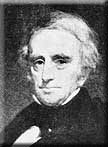
Clement C. Moore
Born 1779  Died 1863
Died 1863
Clement Moore was a scholar who graduated first in his class from Colombia in 1798, and went on to be a professor of classics at the General Theological Seminary in New York City. He spoke at least five languages including French, Italian, Latin, Greek, and Hebrew. In fact, one of his works was a two volume dictionary called A Compendious Lexicon of the Hebrew Language.
He was also one of Manhattan's first real estate developers, and was key in the creation of the neighborhood Chelsea--where his estate was located--of which he donated Chelsea Square to the General Theological Seminary. He also designed St. Peter's Episcopal Church, which was the first church in New York City to be built in the Gothic Revival style.He was a wealthy biblical scholar who saw to it that his family was comfortable. He had married much younger than his age, and his wife, Catherine Elizabeth Taylor, bore him nine children before she died at age 36.
He is best known for the Christmas poem, "The Night Before Christmas." According to legend, Moore wrote the poem, then called "A Visit From St. Nicholas" for his family and children during a sleigh ride home from Greenwich Village on December 24, 1822. This poem is responsible for creating what is now the American image of Santa Claus, but there is disagreement as to where the inspiration for the St. Nick in the poem came from.
Before 1820, St. Nicholas was seen as stern, a thin bishop who visited children to discipline and give gifts, though not always on Christmas Eve. "A Visit From St. Nicholas" turned him into Santa Claus, the thick, jovial, gift-giving man in red, whose attire closely resembled that of the Dutch burghers. Some say that the poem's St. Nick was based on the Dutchman who drove Moore's sleigh that Christmas Eve, but others consider it more likely that the images in "The Night Before Christmas" came from literature. Although Moore is credited with coming up with the concept of flying reindeer pulling Santa's sleigh, the first known references to the sleigh and reindeer are in a Christmas poem published in 1821, called "The Children's Friend."
There is also disagreement as to the names of a couple of Santa's famous reindeer. Apparently, Blitzen's name was originally Blixem, meaning "lightning" in Dutch-American, and Dunder, meaning "thunder," became Donder, and then Donner.
According to legend, Moore never intended to have the poem published, but merely wrote it for his children, calling it a "trifle." Eventually, a family friend, Miss Harriet Butler, managed to anonymously submit it to an out-of-town newspaper, the Troy Sentinel, in 1823. The poem was an instant hit, and was reprinted in newspapers, magazines, booklets, and anthologies around the world. It is now one of the most widely read Christmas poems on the globe.
Finally, in 1844, supposedly at the urging of his family, Moore took credit for the poem, and published it in a volume of his collected works, still calling it "a mere trifle." Ironically, Professor Clement Clarke Moore, who wrote books, founded Chelsea Square, and designed St. Peter's Church, is best remembered for "The Night Before Christmas," which inspired illustrator Thomas Nast's pictures of our modern American Santa Claus. Clement C. Moore died at age 83, in 1863.
Biography by Alice
Submitted unknown
http://urbanlegends.about.com/library/weekly/aa121097.htm
Rebecca Hanneman. "Collecting Clement Clarke Moore." http://collectbooks.about.com/library/weekly/aa112200a.htm [9 December 2001]
David D. Kirkpatrick. "Literary Sleuth Casts Doubt on the Authorship of an Iconic Christmas Poem." New York Times. 26 October 2000.
http://www.nytimes.com/learning/general/featured%5Farticles/001027friday.html
"The Night Before Christmas Poem and its Parodies." http://www.fsu.edu/~speccoll/night2.htm [10 December 2001]
"A Visit From St. Nicholas - About the Poem & Poet." Troy's Community Newsletter. 2001. http://www.uncle-sams-home.com/tui/199912/a1999121123455002.html [10 December 2001]